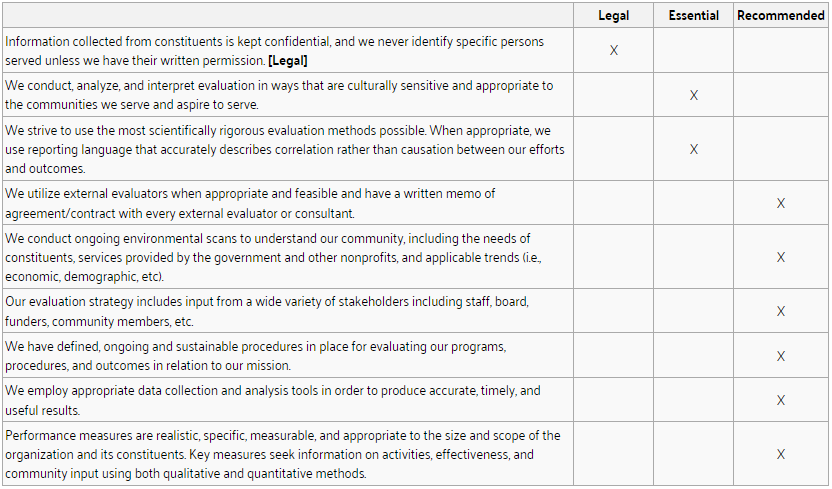Guidelines and Principles: Evaluation
Evaluation drives growth and improvement.
12 Major Areas of Nonprofit Management
As entities that serve the public, nonprofit organizations have an obligation to demonstrate their value to the public. The public has a stake in nonprofit performance and is entitled to information regarding organization results. Nonprofits should regularly measure their performance against a clear set of goals and should share such information with their constituents. Nonprofit evaluation should be appropriate to the size and purpose of the organization and evaluation data should be used to continually improve the quality of processes, programs and activities.
Assessment Items
Methods

Use of Results

Resources
Best Practices
Methods
- When designing a new program or project, identify very specifically how it will impact your mission through measurable outcomes and by addressing identified needs.
- Take time to develop the theory behind the expected relationship between your programmatic efforts and intended outcomes. Discuss the “how,” “why,” “who,” and “when” you expect to see changes. Be careful not to just jump right into tracking metrics that have face value.
- In conducting evaluation, strive to use the most scientifically rigorous methods possible, including external evaluation, while taking into account resource limitations and/or ethical constraints.
- Client testimonials and stories, while potentially valuable for marketing and fund development, are not by themselves evaluation strategies. Similarly, service counts are necessary for reporting volume of service, but are not evaluative of impact or effectiveness on their own.
- Plan on at least 5% of a program’s budget for evaluation costs. This is a commonly accepted range for funders, and includes the cost of staff time to develop and process evaluation tools, copying, postage, etc. If you use an external evaluator, the cost jumps to 10% or more. Research in advance what method/approach is best for each program.
- Evaluators should follow the national Guiding Principles for Evaluators set forth by the American Evaluation Association. https://www.eval.org/p/cm/ld/fid=51.
- Consumer feedback should be a significant component of ongoing evaluation efforts. Develop an evaluation plan (including surveys, focus groups, post-service feedback and other tools) that includes regular consumer feedback. Have the board review results of the feedback and discuss both successes and challenges. Board recommendations should be carried back to staff (via the Executive Director) for program evaluation and adaptation as needed.
- Familiarize yourself with various methods of evaluation to determine which approach is best for individual programs and projects; one size does not fit all. Establish with staff that evaluation planning is an up-front activity rather than a last-minute reaction. Solid goals and objectives lead to effective evaluation plans.
Use of Results
- Establish a process for periodic review of evaluation feedback. If you run frequent programs/projects, you may consider compiling results of like programs for a thumb-nail sketch to present to board members.
- Review evaluation feedback with staff following each program/project. Generate a list of improvements or “lessons learned” and file it where it will be incorporated into planning upcoming projects.
- Develop a mechanism for sharing evaluation feedback with key stakeholders. Consider devoting a section of your newsletter to “recent feedback,” or including anecdotal and hard data in your annual report. You should be able to show your impact on the issue as effectively as you can demonstrate your passion for the cause.
